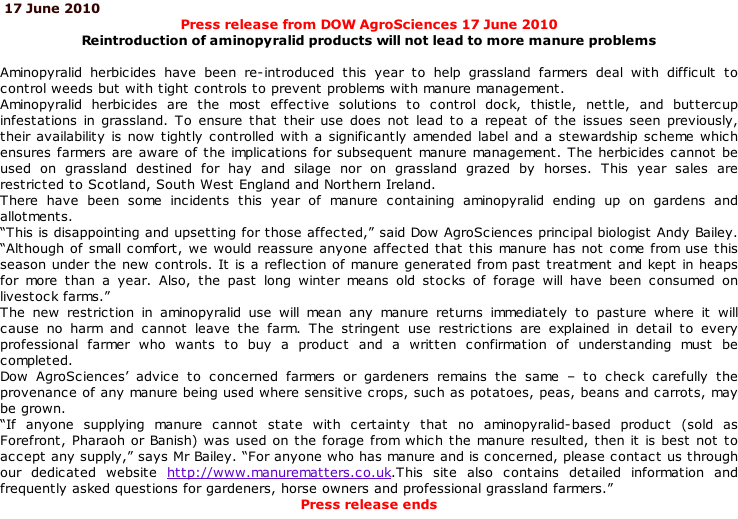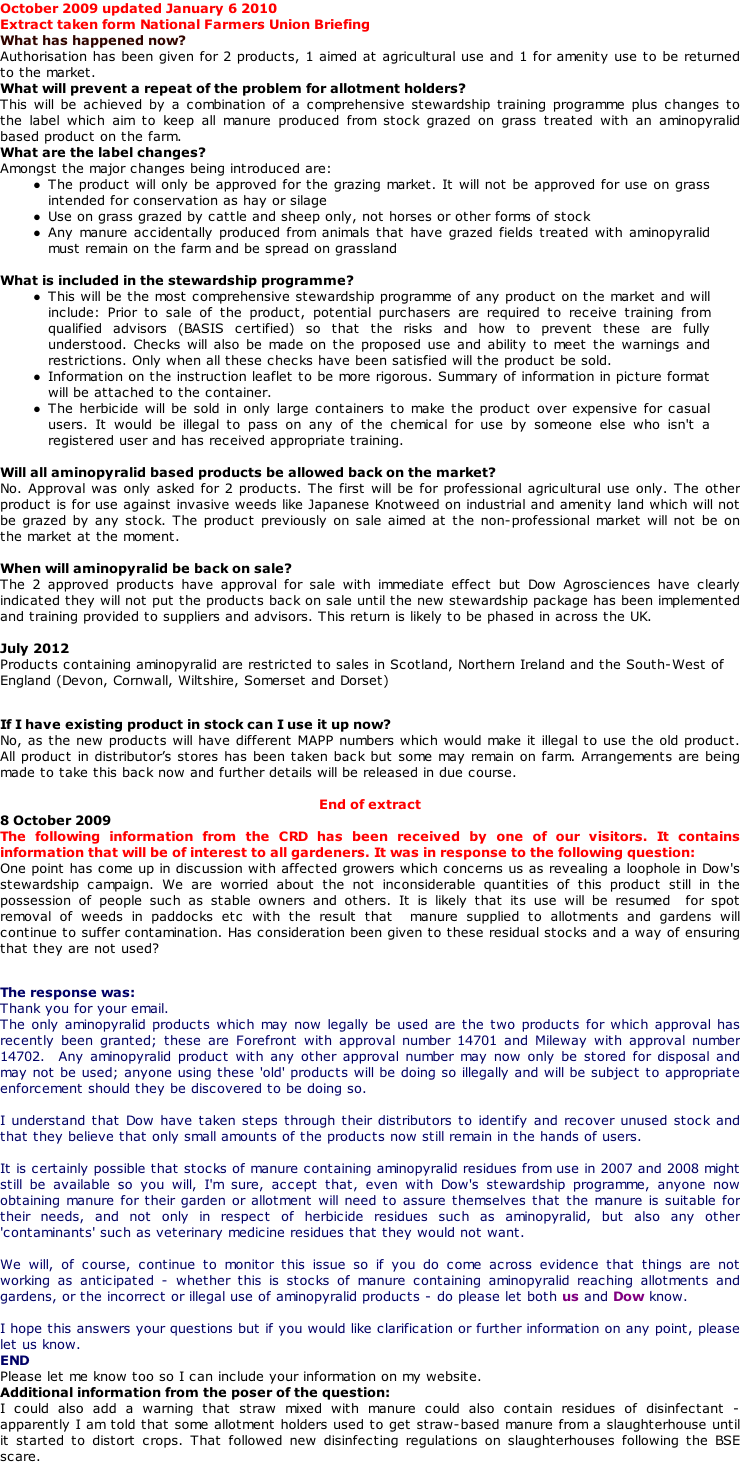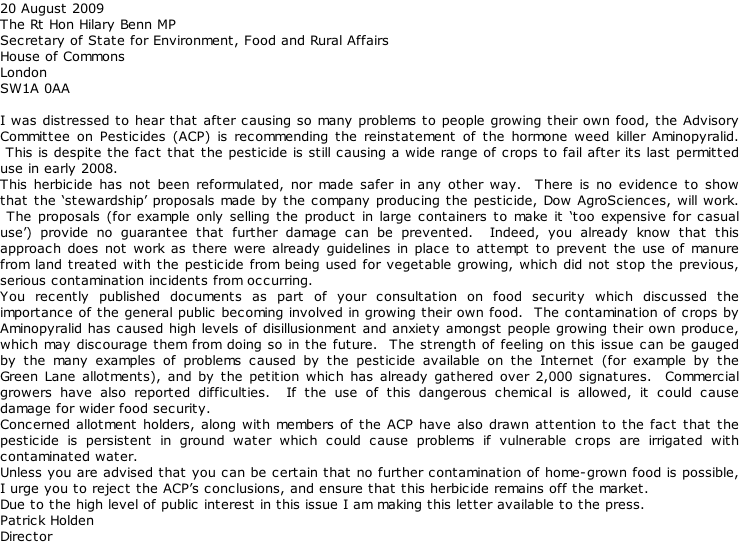


Our Plot at Green Lane Alloments Blog | Our Weather Blog | School Vegetable Patch Website | School Vegetable Patch Blog
© Our Plot on Green Lane Allotments -

|
Why not browse the rest of my site too? - |
|
Ministers agree to the ACP recommendation to reinstate the licence to supply aminopyralid based products |





The petition has now closed. It gathered over 2,600 signatures and so the PM will have to give a response. A link will be published here to the PMs response when it is available.

Someone today told me they had signed the epetition but they are not on the list. If it has happened to one it is likely to have happened to other people. When you sign up an email is sent to the email address that you gave. You have to verify this in order for your name to be added -
If you can't find an email then you will need to sign up again.
Extracts for minutes of ACP meetings
Prosposal for revised stewardship of aminopyralid
Letter from Soil Association to Hilary Benn
5 June 2009 Extract from -
5. Agenda Item 5: Applications for the use of ‘Forefront’ and ‘Runway’ (now known as ‘Mileway’) water in oil emulsion formulations containing 30 g/l aminopyralid and 100 g/l fluroxypyr, as an agricultural herbicide and horticultural/industrial herbicide on grassland and amenity grassland [ACP 7 (337/2009)]
5.1 Members considered the applications for the re-
5.2 Members agreed that the applicant had taken all reasonable steps to manage manure contaminated with residues, through the proposed stewardship campaign, training and monitoring. However, there was some concern about the practicalities of the programme which would need to be addressed and closely monitored as part of the stewardship programme.
5.3 Members noted that aminopyralid was persistent in ground water, and that further confirmation of the effect of irrigating vulnerable crops from ground water sources was required.
5.4 Members were also concerned that approval in Europe could result in UK stewardship measures being by-
5.5 Subject to satisfactory resolution of these outstanding questions, members were minded to advise Ministers to re-
21 July 2009 Extract from -
3. Agenda Item 3: Matters arising
3.1 (a) Aminopyralid [ACP 12 (338/2009)]
3.1.1 Members considered further information requested following discussions at the 337th Meeting on 12 May 2009.
3.1.2 After consideration of this information, the ACP advised that approvals could be reinstated subject to the rigorous conditions of the stewardship scheme which would stop the supply of manure containing residues and provide testing advice and equipment, as well as a removal service for any remaining manure containing residues on allotments or gardens.
3.1.3 The Committee noted email correspondence from allotment holders received prior to the Meeting, and discussed methods of providing information and reassurance. It was agreed that the ACP would produce a press release in addition to any action by CRD if their advice is accepted by Ministers.
6 October 2009 Extract from -
Aminopyralid Letter to Allotment Holders ACP 12 (339/2009)
Aminopyralid Correspondence ACP 18 (339/2009)
Minutes have very little mention of aminopyralid other than
Agenda Item 2: Secretary’s report.
2.1 The Secretary to the Committee reported on the recommendations made at previous meetings. Members heard that Ministers were considering advice given at the last Meeting on aminopyralid.
11. Any Other Business
11.1 The Committee considered the items for information received since the last meeting.
It would seem that the matter is now in the hands of government ministers
Click here for full minutes on ACP website

Main points of the stewardship proposal
- The herbicide will be sold in only large containers to make the product over expensive for casual users. It would be illegal to pass on any of the chemical for use by someone else who isn’t a registered user and has received appropriate training.
- There will be specific compulsory training in supply and use of products containing aminopyralid at supplier and user level. Users/suppliers must sign to say they will distribute/use the product in accordance with the training/instructions
- Names of suppliers/users are to be kept on a database which should mean tracking misuse is easier. This list would be made available to authorities investigating cases of misuse.
- Information on the instruction leaflet to be more rigorous for instance any manure produced must be disposed of on the site and not passed on to anyone else.
- Summary of information in picture format will be attached to the container.
- Contract sprayers will have to sign up to the stewardship as with any supplier, and inform the farmer of the restrictions and ensure the farmer signs the stewardship document. Contractors will have to sign up to all the restrictions that a distributor would. They would also need to get the sign-
in of the farmer client. - The product will only be approved for the grazing market. It will be illegal to make hay or silage from the grass. This will be highlighted in the stewardship document that the farmers signs.
- Any manure produced from animals that have grazed fields treated with aminopyralid must remain on the farm on stables at which it was produced.

The following responses were received in my email to the CRD sent on 8 October 2009.My questions are in green and the CRD response is in black.
Start of email:
Thank you for your email. I've tried to address in turn each of the points you raise (for ease of reading, I've taken the liberty of numbering these). I hope they make sense.
You will probably also be interested in the evaluation document on aminopyralid which should be available on our website in the next few days or so, and which provides a lot more information about all aspects of the aminopyralid issue.
I hope this answers your questions but if you would like clarification or further information on any point, please let me know.
1. It is not surprising that less cases of contamination have been reported this year for various reasons. One being the suspension of use of the chemical, another being that gardeners in 'the know' are avoiding using manure and those who are still unaware of the problem are probably as usual putting any problems down to poor weather, or poor cultivation.
The point about fewer cases of contamination being reported this year is that it indicates that the situation is not getting worse (and might even be improving) which suggests that some of the steps taken to try and deal with the problem -
2. I am afraid that in spite of the assurances that an awareness campaign has been mounted there are many who are still in ignorance. Ordinary gardeners and allotments holders do not access those areas of the Internet where official information has been posted -
The issue has also been aired in the gardening press (including to my specific knowledge, in the RHS "The Garden" magazine and in "Kitchen Garden" magazine), and on the BBC's "Gardeners' Question Time". The RHS, the National Society of Allotment and Leisure Gardeners, and the Allotment Regeneration Initiative have also made wide use of the aminopyralid information cards, particularly at gardening shows and exhibitions. No information/awareness campaign can realistically expect to reach every single person who might possibly be affected by a particular issue, especially if such a campaign is being run on a limited budget. The "law of diminishing returns" starts to apply and reaching the next segment of the target audience requires many more resources than were required to reach the previous segment.
3. Information supporting reinstatement cites the fact that certain weeds are dangerous to livestock and that AP protects livestock by effectively removing the weeds. If this is a reason for reinstatement then I am surprised that it is not available for use in fields browsed by horse. I understand that there are other products on the market that control weeds such as ragwort, the difference being that these are not as persistent and so require more applications than AP products. It is the persistence of AP and its efficacy that creates the problem. Persistent weedkillers are more likely to cause damage outside of the area being protected.
Aminopyralid is very effective at controlling weeds in grass and would, indeed, be useful to horse owners. However, horse owners and stables are likely to have fewer ways of disposing of any manure than farmers, so there would also be an increased risk of manure containing aminopyralid being made available to gardeners and allotment users, and this is the last thing anyone wants. On balance, therefore, it is better to restrict use to those situations where greatest control can be applied.
4. You indicate that extensive training will be given to ensure that people understand the implications of using aminopyralid and also that it will not be available to use on fields browsed by horse or for silage/haylage etc. Have you considered that there will be products that were stored after the suspension which will be used without considering new requirements. News will travel by word of mouth rather than by reference to official notifications. This may well be illegal but culprits would need to be caught and misuse proved -
I understand that Dow have gone to some effort to trace and recover stocks of the old aminopyralid products held by users and believe that only small amounts of those products now still remain in the hands of users.
It is quite important to differentiate between the use of aminopyralid (in other words, the spraying of the pesticide) with the inappropriate disposal of any manure which contains aminopyralid residues. We are not aware of any cases where aminopyralid has been applied to grass incorrectly; we are aware of many cases where manure containing aminopyralid has been supplied inappropriately to gardeners and allotment users with the results with which you are familiar. But, as you will know from my previous emails, the disposal of manure from farms and stables is not particularly well regulated (nor is it something that we have the power to regulate) which makes it very difficult to provide effective enforcement.
5. I apologise for a certain amount of scepticism but being trained to use a product doesn't ensure that trainees use correct methods after training. For example once an individual passes a driving test many will drive illegally. If people feel they get 'get away' with cutting corners then they inevitably will. It will remain extremely difficult to prove misuse.
The training is part of Dow's stewardship programme so this is probably something you should take up with them.
6. I also am concerned that too much reliance will be placed on the suggested bio-
The bioassay test might not provide a definitive answer but given that the only alternative at the moment is an expensive, technically complex analysis process which also might not provide a definitive answer, the bioassay does at least provide an indication of the state of soil or manure which would appear to be better than nothing. You are, of course, correct in saying that it cannot prove that aminopyralid is not present, but it should, hopefully, stop someone from sowing or planting in soil which definitely won't support a crop and that would seem to be a fairly useful result.
7. As for which crops are sensitive -
This also means that the same crop being grown on two different allotments might well be affected to different degrees.
8. A new concern that I have is regarding the information that an AP product is going to be available for use on amenity properties. The examples cited as suitable for application of an aminopyralid product are the very types of environment that currently support a whole array of indigenous species -
The use of any herbicide on an area which supports a range of plant (and animal) species is likely to result in a loss of biodiversity since the herbicide will be being used to control one or more groups of plants -
END


Re Manure Matters website:
After reading the section for manure suppliers on the ManureMatters website a couple of statements made me wonder so I put a couple of questions to DOW.
Firstly the response to the question;
Can we accept manure from treated paddocks? was:
Twelve months after treatment, manure generated from animals grazing fields or eating forage that has been cut from them, is considered aminopyralid-
My query to DOW was:
There was only mention of animals grazing and not that aminopyralid could have been used on bedding material.
DOWs response was;
The most commonly used bedding material for UK livestock is straw derived from cereal crops such as barley or wheat. No products containing aminopyralid have been developed for use on cereal crops grown in the UK. No products containing aminopyralid have ever been approved for use on cereal crops grown in the UK. Therefore, no cereal crops grown in the UK should have residues of aminopyralid derived from direct application to those crops.
If manure generated by livestock fed on forage from pasture treated with aminopyralid is applied to land prior to establishing a cereal crop, the straw from that cereal crop will not contain residues of aminopyralid in sufficient quantities to cause problems to sensitive crops. If the suspension of the approval of products containing aminopyralid is lifted, the new product label will not allow application of manure that may contain residues of aminopyralid to crops other than grassland, thereby removing this concern.
Secondly the response to the question;
How can we tell if there is any aminopyralid in the manure? was
Dow AgroSciences has developed a test to check whether manure or compost contains residues of aminopyralid. (See "What can I do" in the panel on the right).
(The test in the panel is the now well known broad bean test).
My query to DOW was:
Isn't it a bit dodgy advising manure suppliers that if they run the test DOW recommend then the manure is safe?
DOWs response was:
This manure test has been put in place as a simple procedure for manure suppliers to check whether residues of aminopyralid might be present in their stocks of manure. A positive result would obviously indicate that the manure should not, under any circumstances, be supplied to gardeners or allotment-
Questions about the source of the manure, and forage within the manure, should always be asked in conjunction with carrying out the test. The test alone should not be relied upon to guarantee the provenance of manure supplies. Gardeners and allotment-


Back to top of page
Back to contaminated manure menu page
